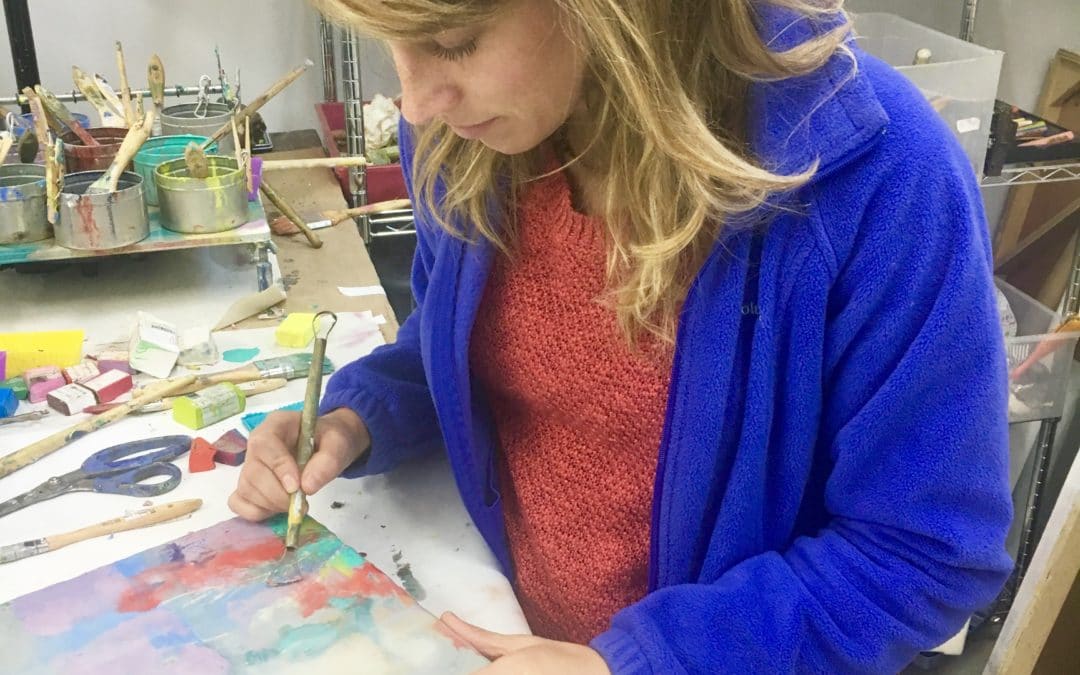Contributed and authored by Isabelle Powell. Many thanks!
“Grief and art are similar in that they both elicit physical energy. Neither grief, nor art-making, are linear, but more spatial matrices”, explains Rachael Morgan, Licensed Professional Counselor (LPC), MA, ATR-BC. “The process of making art helps resolve conflict, reduce stress and achieve emotional well-being. It is used successfully in behavioral health hospitals, community centers, schools, nursing homes, prisons, corporations, and more.”
An Alternative Therapy
Art therapy has proven to be an effective alternative for those who are turned off from traditional therapy. It can be especially helpful for people who struggle with communication or have difficulty sharing emotions. Because art therapy adds an element of focus to the discussion, it allows participants to decrease their defenses and work through their personal grieving experience in a safe place. Art is very helpful with teenagers who have experienced poor outcomes with traditional therapy which are more talk-oriented.
Rachael is based in Asheville and has been practicing art therapy for 8 years. She recommends the method for any one dealing with feeling stuck from unprocessed grief or other painful emotions – from those individuals who are facing a terminal illness, to those who have been left to carry on without a loved one. “Anyone over the age of three is a candidate,” notes Rachael, “it’s really just an exploration of emotions. Art is a symbolic language and art therapy allows you to process and understand those emotions in a safe place – especially when it’s hard to put words to what you are feeling.”
About The Artwork Created
Rachael says that although sometimes the work created in art therapy sessions is beautiful, it is not expected to be shared. “It’s personal, and the art therapist considers it a part of a confidential medical record. There is no need for it to be shown to others, so you do not have to hear others’ comments.” She suggests a few alternate options:
“Cut it up.” A physical way to rid yourself of unwanted feelings.
“Ask your therapist hold on to it – a metaphor for letting them hold onto your pain for you.”
“Put it in a safe place and bring it out as a memory.”
This is not art that’s made to be hung on the wall. Talent and skill are not relevant. Art therapy focuses more on the process than the product.
The Art Therapy Session
So, what should you expect in an art therapy session?
A session typically begins with dialogue about what’s happening or what you want to focus on in the session. From there, the art therapist may give an open ended art task with multiple materials, and ask for what was discussed to be expressed with lines, shapes, and colors. Or the art therapist may give a more specific directive like “draw a bridge going from one place to another place.” Most of the remaining time is spent in silence, allowing you to concentrate on transmitting thoughts and feelings into freeform art. Painting, collage, drawing and clay-molding are commonly used channels of expression. Sometimes the last part of the session is left for verbally processing the art. Each therapy session is unique to the material presented for discussion, and to the client.
Each session lasts about an hour and closes with the therapist reminding you how important – and healthy – it is to use all senses throughout the grief or healing process, and in life in general. Art therapists know how powerful this experience is, and are trained to help the client “contain” the experience and “safely close back up” whatever was opened and explored during the session.
Benefits can be felt from just one session, but each meeting builds on the last – and offers a chance to revisit an older piece or create a new piece of artwork each time.
Learn More
The underlying goal of art therapy is to help individuals gain insight; recognize and uncover their emotions as they heal. Additionally, clients are taught skills for coping and for making positive changes wherever possible.
People have been using art as a form of healing since stone age. Art therapy, in an organized form, was more widely introduced in the 1940s and saw huge growth in the 1970’s, when the scribe school program and masters level of education on the subject were established.
Learn more by talking to Rachael and asking questions.
If you or a loved one have additional interest in the benefits of art therapy please connect with Rachael at www.avlholisticcounseling.com or by phone, for a free 15-minute consultation, at (828)-712-2061.

